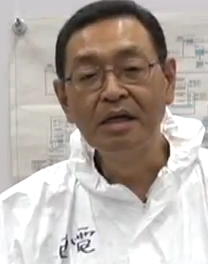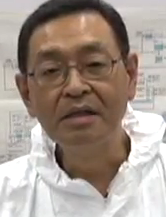Masao Yoshida, a career nuclear engineer and the manager during the crisis at the Fukushima Daiichi plant, who bravely led the fight to bring the reactors under control, has stepped down after directing the disaster team for almost nine months from inside the plant. Yoshida, 56, has just been hospitalized but declined to reveal his illness or his radiation exposure.

Yoshida hospitalized on doctor's advice
According to the DailyMail:
Mr Yoshida's sudden illness comes just weeks after addressing journalists who had visited the plant earlier this month for the first time since the catastrophe. He said: 'In my first week immediately after the incident, I thought a few times 'I'm going to die."'
He also formally apologized for failing to prevent the meltdowns. He went on to say that plant conditions were improving to the point where a 'cold shutdown' would be possible by the end of the year. Here is an earlier Masao Yoshida apology video (video removed from YouTube), expressing his regret and personal sense of responsibility. After Yoshida's departure, The Guardian also revealed a recent letter he had sent to his staff:
"On doctors' advice, I have no choice but to be hospitalised for treatment," Yoshida, 56, reportedly said in a message to staff. "It breaks my heart to have to bid farewell in this way to all of the people with whom I have worked since the disaster."
Loyally, reactor staff followed Yoshida's controversial orders
During the disaster's early days, as radiation levels dangerously spiked, Tepco--the Tokyo Electric Power Co.--pulled most workers out of the plant, leaving Yoshida and what became known as the "Fukushima Fifty," a small beleaguered group who risked their lives to bring the reactors under control.

Yoshida then became famous after clearly and firmly telling workers to disregard Tepco's (whose logo looks like a Japanese feudal banner) order to stop injecting seawater into reactors to bring down soaring temperatures as soon as the crisis spilled out of control. With the supply of fresh water to cool the reactor running out, workers had began injecting seawater shortly after 7 p.m. March 12, wrote the Japan Times. Tepco's head office had told Yoshida to stop the seawater injection after a utility official dispatched to the Prime Minister's office reported to his superiors that there was "a feeling that seawater could not be used without the prime minister's decision."

Yoshida (channeling The Seven Samurai's Takashi Shimura, one of Japan's most famous actors) stepped outside official protocol and told his workers, "I will order you to stop the water injection . . . but do not listen to it," according to sources, before instructing them to stop the seawater injection. Loyally, workers continued injecting seawater into the reactor. Most experts feel that he kept the meltdown from growing much worse--into a desolate radioactive theme park where household pets start to look and sound like Pikachu.
Tepco tried to save face and salvage its authority

Based on a report from Yoshida, Tepco (to save face with the public) announced that the seawater injection had been suspended from 7:25 p.m. to 7:55 p.m. But two months later, Yosida revealed that the injection had not been suspended and he had been reprimanded by Tepco. His level-headed defiance elevated him from the boss of the "Fukushima Fifty" to a living cultural ideal: Director Akira Kurosawa's quietly heroic bureaucrat in Ikiru (trailer) or the bold leader of the Seven Samurai-- which probably makes Tepco the film's marauding, rice-pillaging, badly shaven brigands who terrify (all-in-a-day's-work) the film's rice farmers. Here is the trailer for the 1954 samurai film.



Comments
Yes, in many ways Yoshida is similar to Sully Sullenberger, showing cool courage & composure "under fire". I admire the “Fukushima Fifty” for what they all did fully knowing they were putting their lives at risk to help mitigate the scope of the disaster. Let’s hope we take all the lessons learned and incorporate them into our advanced reactor designs with passive back-up cooling systems, so as to eliminate the need for such extreme sacrifices in the future. I salute the courage of the “Fukushima Fifty”, much like I applauded the courage of the Seven Samurai when first saw that movie years ago in a NYC theater, great story.
Rich- It's always a pleasure to hear from you. Glad you liked the article. It's always nice to see heroism outside of the movies. I've been looking into some of the new reactor designs and I like the whole concept of the smaller, modular prototypes that can expand with population growth (great in third world economies with smaller grids), incorporating all the latest 2nd and 3rd generation safety features. A lot of people are starting to look into these: even Bill Gates has thrown a huge chunk of money into a modular startup.